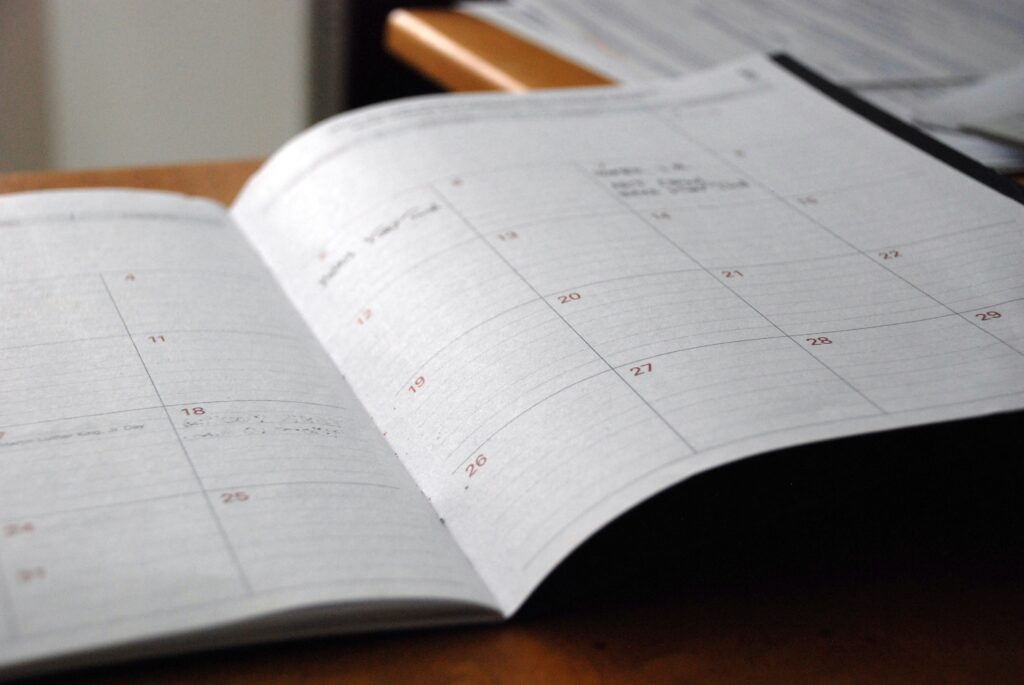[ad_1]
It’s the start of a new year, which often means new beginnings. With that said, many of us decide to set goals known as ‘resolutions.’ However, goals can come in other forms as well, with one of them being a goal statement.
Instead of setting a new habit, writing a goal statement allows us to pinpoint the ‘wants’ and ‘needs’ of our lives. This allows us to see how we can make the change from our current self to our future self. If we want a better job or a promotion, we can be sure to write this goal down as a sentence, track it, and work towards it.
Now, you surely have heard of a mission statement and they are typically associated with businesses. So, you may be wondering; “What exactly is a goal statement?”
What is a Goal Statement?
Whenever you thought of a personal goal, you probably would have written it down Then over time, kept track of it, and continued to manifest results. You probably thought of something that you really wanted to achieve, and decided that the outcome would be worth it.
So, you decided to work hard towards the goal, regardless of any obstacles or situations that may arise. But in the end, the goals that many of us write in our notebooks are usually results-oriented.
We typically think of the end picture and write what we want to happen, kind of like a vision statement. But we rarely break these goals down into steps and we rarely describe why we want to achieve such goals.

However, writing a goal statement will solve all of those issues. Instead of outlining the specific results, the goal statement will allow us to analyze why we want to achieve the goal and how we will achieve it. This makes it action and process-oriented.
Whenever we are feeling devastated and hopeless, we can read our goal statement for some motivation. Plus, we can also add this statement on our cover letter and resume.
The Benefits of Writing a Goal Statement
Goal statements do come in handy when needed. Though they may be difficult to brainstorm, there are multiple advantages which outweigh the costs. Some of these benefits include:
1. They provide direction and motivation
Whenever our goals and processes aren’t written down, we may find it difficult to focus on one path or outcome. Our personal life circumstances in are always changing, which makes it difficult to stick to a previous goal we’ve set. And due to all of this, we may forget about our goals before attempting to try.
But there’s a way to remember them! When you write these goals down and explain the process in terms of achieving the outcomes, you’re more likely to work towards them.
The statements can provide you with a sense of direction in life as they will help you identify your own values. In fact, research even supports this strategy as well.
Hence, having a goal statement will give you a sense of direction and motivation. You know what you’ll aim for, and you’ll be able to track your progress towards the ultimate goal. This way, you’ll never lose sight of the bigger picture.
2. Goal statements allow you to work towards your own true values
Your goal statement is entirely personal and customizable, depending on your needs and characteristics. By writing down a goal statement you’ll be able to pave your own path towards self-development.
You can chose one which which resonates with your current aspirations, without worrying about the needs of others around you. Hence, goal statements allow you to see the potential you have within yourself.
Once you identify your own potential, you’ll feel more confident. This can also bring some clarity on long-term career goals or relationship goals.

3. They emphasize the importance of action, not just words.
Oftentimes, we rely on words in order to motivate ourselves. For example, remember when you have to do chores? Throughout the process, you’re probably thinking of how good it must be to have some chores completed.
After all, your house will look tidy and organized. To remind yourself, or motivate yourself, you may tell a friend, “Oh, I do my chores on Sunday.” However, Sunday arrives, and you’re exhausted and find yourself recuperating for the week ahead.
Sometimes, we use words to give ourselves a confidence boost. We tell others what we’re doing to remind ourselves to get started on a particular task. But although words are a great motivator, they won’t necessarily help you complete a task.
In order to reach the finish line, we’ll have to work towards action. Fortunately, goal statements will help us with that.
When we’re writing the goal statement, we’re not just thinking about the words and the result. We’re instead thinking about the actions, and the process, which puts us on the right track to reach our long-term goals.
How to Write a Goal Statement
There are many methods in terms of writing a goal statement. You can take inspiration from a few, but you shouldn’t just be regurgitating the goal. Remember, you want a goal with results!
Instead, you need to think of the process and the value of the goal. Now, you may ask, “How can I identify that?” Well, let’s explore how to get that started:
1. Ask yourself what you desire to achieve
You know those days when we all lie in bed, and wonder what happened to our previous dreams and desires? If you have a previous dream or desire which you still think about fulfilling, keep track of this and perhaps jot it down.
There may be a reason why you continue to think about it. Our passions and callings in life tend to keep making themselves evident. You may find yourself considering a career change or re-examining your social networks.
Perhaps this dream can be one of the smart goals you wish to fulfill in the future. Write down this vision statement as a spring-board for your goal statement and you’ll be headed in the right direction.
2. Focus on the things that bring you joy
I know it sounds cliché as we probably have heard from multiple people to pursue and “focus on things that we’re passionate about.” However, there’s actually some validity behind the statement.
Imagine working on a goal that you do not necessarily want to achieve, but feel the need to due to external factors. Would you actually be happy once you achieve it? You may answer “No,” because the goal was not something you have envisioned or planned out for yourself.
So, pinpoint a few hobbies or activities that bring you joy. Then, list some of your core values or beliefs. You can tie these elements together and work towards your own personal vision for the future.

3. Identify and believe in the goal statement process
Goals are perceived as destinations. But in order to get to a destination, we must go through a journey. And the journey in itself is a never ending process. Once you set a goal, you shouldn’t forget about this journey.
The journey is filled with wins and losses. Sometimes, you’ll feel as if you’re near your goal, just to have everything robbed from you. However, you should believe that everything that happens is a lesson.
You could also incorporate some smaller steps into your outlined goal as well. These small steps will allow you to allocate your goal into other short-term goals, which can be a benchmark for you to work towards.
When you achieve these smaller goals, you’ll be able to track your progress. Then, you will be fueled by these accomplishments when you feel the need to take on long-term goals.
4. Remember to incorporate action
Many goal statements include an action plan and strategy, which outline the process of achieving the outcome. So, whenever you think of a specific goal, be sure to describe what you will do to achieve it in your statement.
Keep the steps involved reasonable to your skills and abilities so they are practical and achievable. This way, you’ll find a way to take initiative and control of your progress. And, this will allow you to track your own results.
5. Remember there are always external factors
Often when we set a goal, we are so focused on accomplishing it and start to forget about other external factors which may influence our progress. Unexpected events or changes can be discouraging, or even devastating.
For example, when we want to achieve a perfect attendance rate in school or at work. We often forget that there are times when we may be sick, which will prevent us from going to class in the first place.
As a result, when such things happen, it’s best to acknowledge that they’re simply out of your control. And you could only react to them by finding a different way to solve the problem.
In this case, aim for a more realistic goal of 90% attendance rate to account for unforeseen circumstances. Give yourself grace and recognize how the variability of everyday life can influence your goals.

Practical Goal Statement Formats
Now that we covered the basics of writing goal statements, there are multiple goal formulas which we can consider when writing our statement. You can pick any depending on your preferences or goal needs:
1. SMART Goals
I’m sure we have heard of this term from someone, whether it was from the resume and cover letter sessions or the class reflections which we’re required to finish.
The SMART goal acronym stands for:
- Specific: Goals should be specific to you and answer the 5 Ws; who, what, when, where and why.
- Measurable: Goals should be quantified or have a specific metric assigned to them to ensure that you fulfill them.
- Attainable: Ensure that you are not setting too high or too low expectations of the specific goal, and that they are attainable with the current or predicted resources.
- Relevant: Goals should align with your own core values and missions.
- Time-bound: Make sure to specify when the goal can be achieved by outlining the time expected to achieve each step.

Example of a SMART goal:
I want to get a 4.00 GPA next semester by studying and reviewing 2-3 different courses every day for one to two hours, doing the practice questions required, and participating in lectures by answering or asking questions. Before the first midterm, I aim to obtain at least an 80 on one to two assignments.
This goal is specific, as it identifies the situation in the beginning, which is aiming for a higher GPA. It is also measurable as well, as every aspect of the SMART goal is quantified by a number. For example, the 4.00 GPA and the “80 percent on one or two assignments.”
This SMART goal is attainable as the student is not reviewing a full course load everyday. They are only reviewing some portions of the lecture which is a good idea to keep themselves on track toward the ultimate goal.
If the student is looking to improve their study habits, the goal is relevant as well. Moreover, this goal is time-bound as it specifies how much time is needed to reach that finish line.
2. PACT Goals
Another option for a goal-setting method is the PACT formula. The PACT focuses more on the core values and actions of an individual, which may be more of a fit for those looking to write a goal statement.
In a way this is a statement of purpose and with so much potential for personal development. This formula can also be implemented to create a good mission statement.
PACT stands for:
- Purposeful: What does the goal mean to you? How can it change you and lead you to develop into a better person?
- Actionable: What steps can you take towards your goal?
- Continuous: Even if you do achieve the resulting goal, how can you utilize the new skills you gained towards your own personal or professional development?
- Trackable: How can you track your goals? What metrics can you use?
Instead of focusing on specific and measurable goals, PACT goals aim to focus on an individual’s future development based on their own values and characteristics.
Example of a PACT goal:
I aim to try out more activities this year based on my own interests as I aim to prioritize my mental and physical well-being more. Since I prefer moving around on my own instead of going to the gym, I will sign up for a weekly beginner’s dance class. Throughout the weeks, I can see how I progress and see which genres I like. If I do end up enjoying the activity, I will try out more dance genres. I’ll be able to find a new activity and prioritize my physical well-being.
This goal is purposeful, as it outlines the individual’s purpose on why they wanted to set a specific goal. Moreover, steps are also outlined in order to achieve the ultimate goal. For example, signing up for a weekly beginner’s dance class is a good way to start and commit time towards the activity.
The goal is continuous as well, since it states how the activity can benefit the individual in the future. Since the goal is broken down into time periods (weekly), it easily tracks by week as well.

3. GROW Goals
GROW goals require some self-reflection and awareness when analyzing the outcome. However, being able to reflect on your current situation will definitely allow you to realize that you’re able to be in control of your personal life no matter what.
The acronym stands for:
- Goal: What is the desired result?
- Reality: What is happening in your current life right now?
- Obstacles: What are some of the barriers you’re facing?
- Will: How can you overcome these barriers and achieve your dreams?
Example of a GROW goal:
I hope to find a co-op position in the field of sales and communications. Currently, I’m a student and I work two part-time jobs in retail and customer service. I also have rent and other living expenses to pay. Therefore, I do not have much time to apply to positions or to network. However, I do have a decent amount of savings. So, maybe I can switch my work hours and take a week off in order to prepare for interviews and networking sessions. I will be sure to communicate this with my employer.
The example above outlines a GROW goal because the first sentence states the desired result, which is securing a co-op position. Then, the student writes about their current living situation and the obstacles that they are facing.
However, they then decide to address these barriers and find new solutions. This is a vital part of the GROW goal statement to ensure success.
4. HARD Goals
Sometimes in life we all have to make tough decisions and face difficult situations. We often wonder why we made such a challenging decision, and what was the purpose of the decision we made.
When we’re questioning these aspects, a good formula to remember is the “HARD” goal formula. These include:
- Heartfelt: What is your intention when setting this goal? What motivates you to achieve this goal?
- Animated: How will you feel once you achieve this goal?
- Required: What makes it important to achieve this goal?
- Difficult: How difficult will it be to fulfill your desired outcome?

Example of a HARD goal:
After I complete my bachelor’s degree, I aim to hopefully pursue more studies. I noticed that I enjoy being in a classroom setting and learning new topics, and to me, being educated on different subjects is important. I want to learn more about the world and see the world through various perspectives. It is difficult, as I’ll have to sacrifice lots of time and financial resources. But in the end, the time and financial resources will be worth the fulfillment from my education.
In this goal, the writer clearly states the intention by writing why they decided to set the goal in the first place. Moreover, the writer touched upon feelings as well, such as “feeling fulfilled.”
The writer also states the importance of learning more about the world through different topics. Difficulties and challenges are also addressed as well, which include the time and financial resources.
5. OKR Goals
Sometimes, the complexity behind the other goal-setting formulas can be overwhelming. Fortunately, there is an option to goals in a more simple manner.
The OKR goals are a simple way to set measurable outcomes, which are broken down into different benchmarks. It works similar to a vision statement and stands for:
- Objective: What is your big goal?
- Key Results: What results will you need to achieve in order to reach your big goal?
Example of OKR Goal:
My big goal is to one day launch my own startup company. In order to do so, I need to be trained in business operations, accounting, finance, and human resources. I also need to know how to promote and market my brand to my targeted audience as well. I can begin by noticing my interests, creating an inception plan, and pitching my ideas to different ventures. Then once I receive the funding, I can begin with product design and implementation.
In this goal, the objective defined is an individual launching their own start up company. Then, they decide to describe some key results, which include action items such as creating an inception plan. Also, benchmarks such as pitching ideas and receiving funding are outlined.
Goal Statement Examples
Now that we have covered some different formulas regarding goal statements we have a toolbox to get started. It is a good idea to brainstorm some of our most recent needs and see how they can impact our goal setting frameworks as well.
As we have seen, goal statements can be written in a variety of manners. Goal statements are flexible and can be dedicated towards plenty of different industries and settings.
For now, let’s consider three important aspects of our 20s in terms of goal setting: academic, career, and relationship.

Academic Goal Statements
Below are some sample goal statements for those who are in college and university. These goal statements mainly focus on academic performance.
I hope to make it onto the Dean’s Honor List by obtaining over a ___ GPA (as determined by the school) this year. I need at least a ____ GPA for the first and second semester in order to do so. To do this, I’ll set a schedule and dedicate around 2 hours of studying each day and ensure that I attend lectures on time. When I need help, I will be sure to utilize the tutoring sessions offered by the department. (SMART).
I hope to obtain a GPA of 4.00 in one of my human resources courses. Learning about human resources resonates with me as I want to learn more about human behaviour and organizational structures. Being a good student is also what I aim to continue to be as well, since I want more options when I apply to graduate schools. To do this, I can request to seek advice from the professor in regards to unclear instructions, and dedicate around 3 hours of study in this course. I can then utilize these new skills for future courses. My short-term goals can be tracked through the grades of my assignments, whether I see an increase in trend or not. (PACT).
I hope to increase my GPA from 3.8 to 4.0 this semester. Currently, I have to work and fulfill some extracurricular obligations which may take around 20 hours a week. Therefore, I have limited time for studying. However, I can always decide to study efficiently; perhaps, I can decrease some free time and skip Friday nights. (GROW)
I aim to get into law school because I am passionate about the legal industry. I have always read books about law and want to learn more about the subject. Once I achieve this goal, I will feel content and realize that I’ll be able to hopefully achieve my dream job as a lawyer. I do need a good CGPA in order to make it into law school, so I need to put in more effort in terms of studying and consult with my professor for my assignments. (HARD)
I aim to get into medical school after graduation. In order to do this, I will have to dedicate some time to study, perhaps volunteer at the hospital, and join a few extracurricular clubs which are focused on health research. I hope to also gain a research assistant position as well. Then, in my third or fourth year, I’ll prepare and take the MCAT exam. (OKR).

Career Goal Statement Examples
Whether you’re eyeing on a new promotion, or wanting to improve your professional life, having a career path is a big part of being in your 20s. Below are some sample statements of professional goals:
I hope to gain a new promotion from my current position. I can do this by taking on more initiative in tasks, and trying to see what my supervisor may need assistance with. For now, I will try to take on at least one extra project and see if I can collaborate with my fellow team members. Then, in the next month or so, I can perhaps tackle more projects with others and assist my supervisor with more of their tasks (SMART).
I hope to get a position related to my degree, as I studied the subject and enjoyed the material. Then, I can apply my academic coursework into my experience. I will start looking for jobs immediately, and ensure that the jobs I apply to are related to the subject I learned at school. Hopefully, this job will bring me new career growth and opportunities. And overtime, through the interviews, I can see what worked or did not work. (PACT).
I desire to work in the field of accounting as I have graduated from university with a degree in accounting. Right now, I do have the ability to apply to jobs but I am still studying for my CPA exam. I also have a part-time job which may interfere with the interview hours. But to overcome these barriers, I can still continue to apply and see what I can get. I can also ask to get my shifts switched in order to make it to the interviews. (GROW).
I aim to take on more freelance photography projects throughout the year. I like to create different art forms and work with companies and businesses. Once I achieve this goal, I will feel content that more people are enjoying and being exposed to my work. This goal is important to me as my art is a direct reflection of my emotions. To achieve my professional goals, I will continuously need to promote my services on social media and word of mouth, while practicing my skills. (HARD).
My big goal is to become an assistant manager at my community centre. In order to do this, I need to take on a few leadership positions. I will apply to some and go through the interview process. Moreover, I will also ask my current manager for mentorship advice, a performance review, and work more hours in my current position for seniority. Throughout this, I will also become more favorable for a potential employer if I choose to apply for other jobs (OKR).

Relationship Goal Statements
We all know how difficult relationships are to navigate during adulthood. This can range from the friends we meet in class, to the Tinder date who continuously bombards us online. But there also can be goals set for relationships and friendships as well:
I hope my partner and I communicate our issues more transparently. We are in the process of booking couple counselling sessions. We aim to go weekly and we hope that they’ll be able to provide us with a sense of direction. (SMART)
I hope I can apologize to my friend about what I have done previously. I really valued our friendship and believed that I should not have acted the way I did. If I do, I can hopefully build my communication skills and learn to do the right thing next time. This can perhaps also improve the current friendships in my life as well. (PACT)
I hope to get closer to my family, as we once drifted apart during my teenage years. I agree that there were misunderstandings, but now I feel that since I have grown, I finally realize the intention behind their actions. It’s hard to see them currently as I do live away from home, but I will continuously keep in contact with them and see if it is possible to go on trips with them. (GROW)
I hope to get along with my sister as we were once best friends. Since I moved away, everything changed. However, once I begin to communicate with her, we can support each other. After all, family is important. I understand it is difficult as our schedules often collide, but I can always try my best to reach out whenever I can. (HARD)
My big goal is to find myself a committed, loyal partner. It will take time but I will need to first understand the other individual’s personality, and see how compatible we can hopefully be. I need to communicate more about myself and hopefully, the right person will come along. (OKR).

Final Thoughts on Practical Goal Statements
Writing a goal statement is similar to creating a mood-board for your future dreams and career aspirations. It involves knowing what you currently want, and working towards achieving the specified outcome.
Instead of thinking of specific goals, writing goals in the form of statements allows us to see what we truly want, and work towards them. Such statements can allow us to be motivated in terms of completing our personal vision to the next level.
There are plenty of different methods to write goal statements with multiple examples. There is the SMART approach, which is for more specified and measured goals. And there is the GROW approach, which is for goals that resonate deeply with your own personal values and beliefs. The right one is the method which resonates the most with your mission, and motivates you the best.
Once you begin writing down your own goal statements, you may notice small changes in your life. You may notice that you’re more optimistic and perhaps, you may decide to tweak your everyday life routine.
With that being said, achieving goals is not easy most of the time. There are multiple barriers which do get in the way. But when they do, it’s best to take it one step at a time. After all, we can all work towards change throughout our lives. What matters the most to many of us is to not give up.
About the Author
[ad_2]
gentwenty.com







